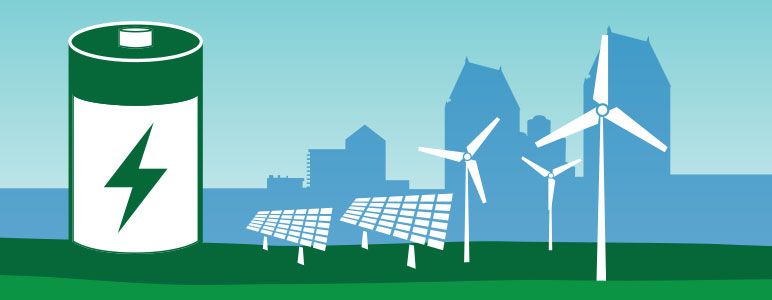
Advertiser Disclosure: At ElectricityRates.com, our number one goal is to help you make better energy decisions. We adhere to strict editorial guidelines, however this post may include references to products offered from our partners.

Changes are occurring within the power industry at both at a faster rate than ever before as well as in new and innovative ways. When looking at the US electric infrastructure, energy storage is becoming increasingly in demand. This growth needed for energy storage on the power grid is driven by a number of factors, including both economic and environmental incentives.
What exactly is the "energy grid"?
The US energy grid, also known as the electricity infrastructure, consists of multiple expansive regions that deliver electricity from the producers (generating stations) to the consumers. It is the web of high voltage transformers and transmission lines that carry power from distant sources to the most remote places across the continent.
As is with any form of infrastructure, big or small, the passing of time causes aging effects that can result in negative societal and economic consequences. Additionally, transformations in technology and types of energy demands are putting strain on the current infrastructure and are becoming a growing concern. Most power plants were built over 40 years ago, and the American Society of Civil Engineers (ASCE) recently gave the entire energy infrastructure avery poor grade of D+ (unchanged from its report card in 2013).
The Need for Change
Today's power demands are radically different than those of the 20th century, which mainly relied on the use of fossil fuels. With increased knowledge of the limited supply of fossil fuels and the devastating environmental impact that comes with the combustion of these resources, the move to renewable energy sources has been increasing in recent years. The US witnessed another increase in renewable energy use in 2017, with renewable sources now representing 18% of all power usage in the country. Additionally, energy demand, which steadily increased for over a century, has remained stagnant over the past 10 years. Today's society is heavily battery-driven, and it is time for our out-dated electric infrastructure to be rebuilt to reflect the changes in consumer needs and desires.
Grid Energy Storage: Smart Grid Technologies
Grid energy storage refers to large-scale energy storage, which utilizes multiple methods within the electrical power grid to store power when it is not needed (i.e. when production of energy supply is greater than demand/consumption), and is ready to be used when demand for power increases. These systems are similar to "smart home" technology, such as appliances that turn off when the home is unoccupied, and utilizing data logging to predict when and how to function in a matter to optimize and preserve energy use. Similarly, "smart grid" technology is an umbrella term used to describe self-sufficient systems of energy production and storage that benefit the power market in a number of ways. These systems, when applied to power grids and traditional power-generators, use sustainable, reliable and safe electricity sources to reduce necessary workforce and provide a quality product to consumers.
Benefits of New Innovations
The dramatic change from a system built in the 1800's to a cross-continental "smart grid" lends itself to an array of promising potential improvements to the overall energy efficiency of the US, many of which can have a huge positive impact on everyday life. For example, energy generators that are mainly computer-based will be able to not only transmit electricity more efficiently, but also restore power after disturbances (think weather-related power-outages) more quickly than before. Our nation has recently faced devastating natural disasters, and having an energy infrastructure that is able to reduce electrical blackouts has the potential to save lives.
However, the most revolutionary day-to-day changes to individual life as a result of smart grid technology include increased consumer control. Currently, many states remain regulated, meaning that individuals do not have any choice regarding where or how they get their energy. Smart-grids allow for increased consumer participation, analogous to controlling your bank account, insurance payments, and other bills and utilities directly from your phone or computer. Additionally, smart-grid based generators have the ability to efficiently integrate not only personal power generation systems (such as those owned by business and homeowners), but large-scale renewable energy systems as well.
What is the Cost?
When analyzing the efficacy of energy storage, it is important to look at the economics involved in this new aspect of the power sector. As with renewable/new energy sources as a whole, setting up a new power generating system is always going to have an upfront cost that is higher than simply maintaining current systems. But, the long-term cost-effectiveness is far superior to maintaining an old, outdated system. For example, installing solar panels in ones home may seem a financial burden initially, with initial costs ranging from around $10,000 to $14,000, but over 20 years (from 2018-2038) the average reduction in electricity costs for an individual home, depending on which state you live in, is estimated to be up to $30,000 in savings. Many new homes are being built with such technologies, which reduces a lot of that initial installation fee to begin with. With the promise of more secure and reliable energy transmission with decreased-risk of long-term interruption of service, the initial cost far outweighs the long-term benefit.
The Future of the Energy Sector
When looking at the development of energy storage, the US is currently the global leader, according to a 2017 report by Wood Mackenzie, with a massive 431 megawatt-hours of energy used last year. To maintain its role as a leader in energy storage, the US must continue to invest in the research and development of new technologies and systems, utilizing both small-scale and large-scale generators of renewable energy, to develop a new, smarter, long-lasting energy infrastructure suitable for the 21st century.


